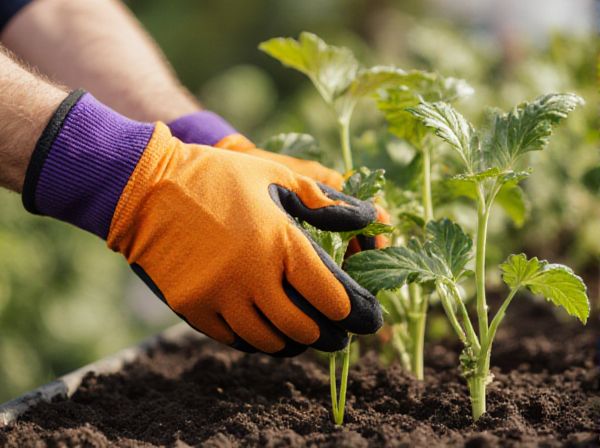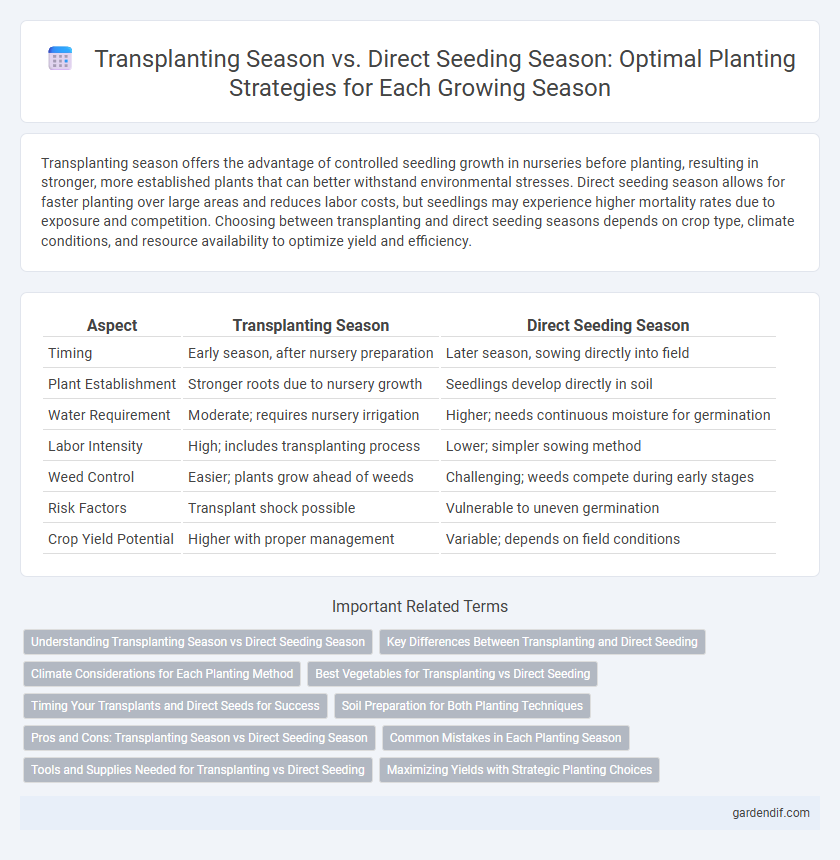
Transplanting season vs Direct seeding season Illustration
Transplanting season offers the advantage of controlled seedling growth in nurseries before planting, resulting in stronger, more established plants that can better withstand environmental stresses. Direct seeding season allows for faster planting over large areas and reduces labor costs, but seedlings may experience higher mortality rates due to exposure and competition. Choosing between transplanting and direct seeding seasons depends on crop type, climate conditions, and resource availability to optimize yield and efficiency.
Table of Comparison
| Aspect | Transplanting Season | Direct Seeding Season |
|---|---|---|
| Timing | Early season, after nursery preparation | Later season, sowing directly into field |
| Plant Establishment | Stronger roots due to nursery growth | Seedlings develop directly in soil |
| Water Requirement | Moderate; requires nursery irrigation | Higher; needs continuous moisture for germination |
| Labor Intensity | High; includes transplanting process | Lower; simpler sowing method |
| Weed Control | Easier; plants grow ahead of weeds | Challenging; weeds compete during early stages |
| Risk Factors | Transplant shock possible | Vulnerable to uneven germination |
| Crop Yield Potential | Higher with proper management | Variable; depends on field conditions |
Understanding Transplanting Season vs Direct Seeding Season
Transplanting season involves growing seedlings in controlled environments before moving them to the field, enabling better root development and earlier crop establishment. Direct seeding season requires sowing seeds directly into prepared soil, which reduces labor and transplant shock but depends heavily on precise timing for optimal germination. Understanding the differences in timing and environmental requirements between transplanting and direct seeding seasons is crucial for maximizing crop yield and resource efficiency.
Key Differences Between Transplanting and Direct Seeding
Transplanting season involves starting seedlings in controlled environments before moving them to the field, enabling better initial growth and protection from adverse conditions, while direct seeding season requires planting seeds directly into the soil, saving time and labor but risking lower germination rates. Transplanting allows for earlier crop establishment and extended growing seasons, whereas direct seeding depends heavily on soil temperature and moisture for successful germination. Crop types, climatic conditions, and soil characteristics play crucial roles in selecting the appropriate method during each season.
Climate Considerations for Each Planting Method
Transplanting season is optimal in cooler climate conditions, allowing seedlings to establish roots before extreme weather changes, reducing stress and improving survival rates. Direct seeding season requires consistently warm soil temperatures to ensure rapid germination and seedling vigor, minimizing exposure to frost or drought risks. Climate considerations such as temperature fluctuations, rainfall patterns, and frost dates directly influence the choice between transplanting and direct seeding to maximize crop yield.
Best Vegetables for Transplanting vs Direct Seeding
Transplanting season is ideal for vegetables like tomatoes, peppers, and eggplants, which require a controlled environment during early growth to ensure strong root development and higher survival rates. Direct seeding season suits crops such as carrots, beans, peas, and radishes, thriving when planted directly into warm soil for uninterrupted root growth and minimal transplant shock. Matching the right vegetables to transplanting or direct seeding maximizes yield, optimizes growth conditions, and reduces labor intensity during the gardening season.
Timing Your Transplants and Direct Seeds for Success
Timing your transplants during the optimal season ensures seedlings establish strong roots before adverse weather, increasing survival rates and overall yield. Direct seeding season should align with soil temperature and moisture levels that favor germination, typically after the last frost for warm-season crops or early spring for cool-season varieties. Balancing transplanting and direct seeding times minimizes competition and maximizes garden productivity by leveraging the strengths of each method in relation to seasonal conditions.
Soil Preparation for Both Planting Techniques
Soil preparation for transplanting season requires thorough loosening and enrichment with organic matter to promote strong root establishment and reduce transplant shock. In direct seeding season, soil must be finely tilled to create a smooth, firm seedbed ensuring optimal seed-to-soil contact and uniform germination. Both techniques benefit from balanced soil pH and nutrient levels, with careful moisture management tailored to each planting method's distinct requirements.
Pros and Cons: Transplanting Season vs Direct Seeding Season
Transplanting season offers early crop establishment, improved plant spacing, and better weed control, though it demands more labor and resources for nursery management. Direct seeding season reduces labor costs and simplifies the planting process, but it exposes seeds to environmental risks and can result in uneven germination and lower initial crop uniformity. Choosing between transplanting and direct seeding depends on available labor, climate conditions, and desired crop timing.
Common Mistakes in Each Planting Season
Transplanting season often suffers from common mistakes such as disturbing the root system during relocation and planting seedlings too deep or shallow, leading to poor growth and increased stress on young plants. Direct seeding season errors frequently include sowing seeds at incorrect depths and failing to maintain consistent soil moisture, which results in uneven germination and weak seedlings. Understanding these pitfalls helps optimize plant health and yields for both transplanting and direct seeding methods.
Tools and Supplies Needed for Transplanting vs Direct Seeding
Transplanting season requires tools such as seed trays, seedling pots, potting soil, and a gentle watering can to nurture young plants before moving them outdoors. Direct seeding season involves supplies like garden trowels or hoes for creating seed furrows, quality seeds suited for direct sowing, and mulch to retain soil moisture. Both methods benefit from soil thermometers and plant markers for optimized planting and monitoring.
Maximizing Yields with Strategic Planting Choices
Transplanting season allows for controlled seedling management, resulting in stronger plant establishment and earlier harvests, which maximizes yields by reducing crop stress and enhancing root development. Direct seeding season offers cost-effective large-scale planting and quicker field turnover, benefiting regions with longer growing periods and minimizing transplant shock. Strategic planting choices leverage these seasonal advantages to optimize growth conditions, improve crop resilience, and ultimately increase overall agricultural productivity.
Transplanting season vs Direct seeding season Infographic

 gardendif.com
gardendif.com